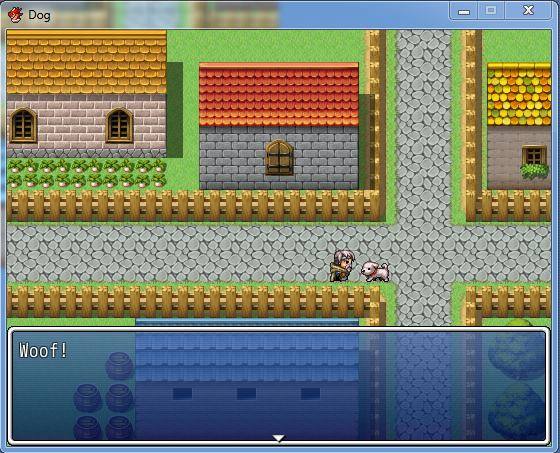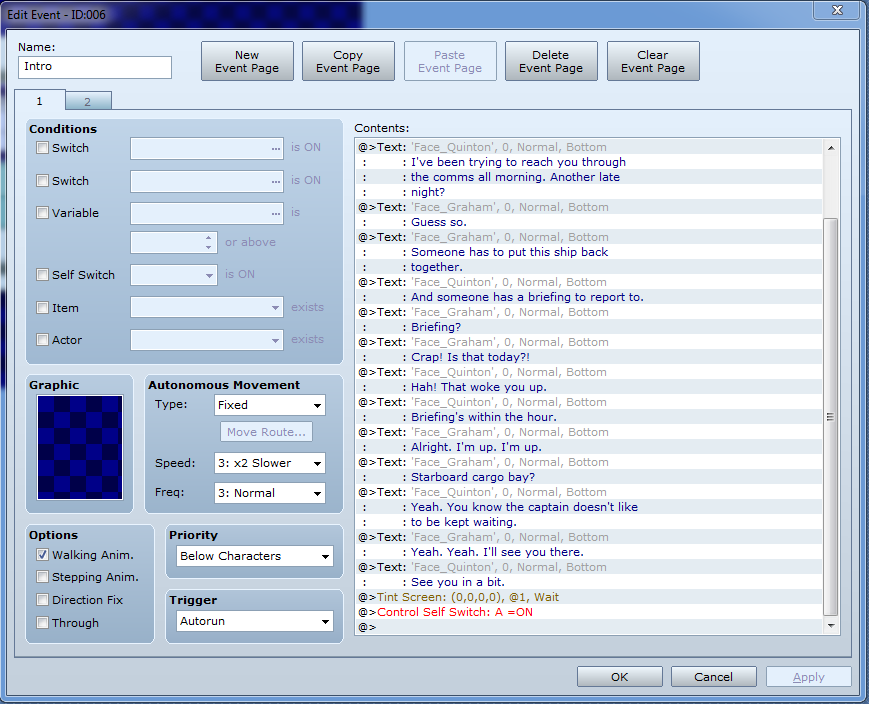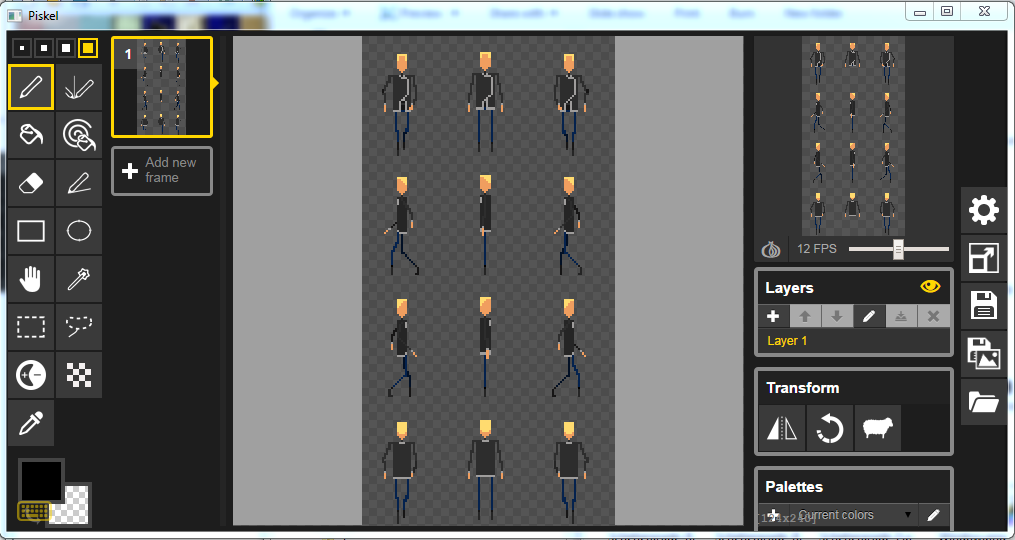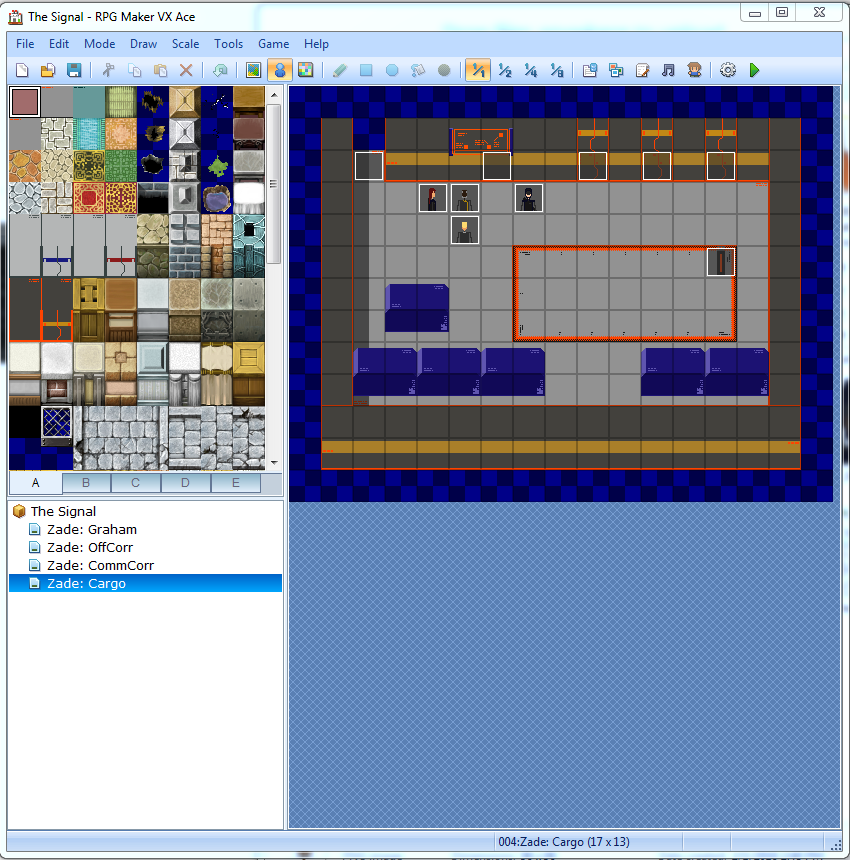Over the course of a weekend, I sat down with RPG Maker, and drank a lot of coffee. By that Sunday afternoon I had something that, while incredibly short, I was very pleased with. If nothing else, “JRPG Jam” was a great learning experience.
There’s a lot of text ahead. Before the need for too much scrolling, here’s The Signal, the game I created over one night and one caffeine-infused afternoon. I apologize for the file size. While the assets I use add up to less than 5 MB, RPG Maker insists on adding all its provided assets to generate its most painless distributable.
Stay Awhile and Listen
This began after a friend of mine finished Undertale. Naturally, we started talking about it. We looked at its narrative. We tore apart its mechanics.
Over the many years that I’ve been playing games, I’ve come to understand why I enjoy those I do, and why I don’t enjoy those I don’t. Sometimes, it’s a very subjective matter of taste. Most of the time, it’s my heavy bias toward systems-driven games. That’s not to say I don’t enjoy games that tell a good story. But given a choice to create something like XCOM and something like Undertale, I’d much rather create something like XCOM.
There’s no reason a game can’t have both interesting mechanics and a good story. However, there’s a point where a game has to lean between being either story-driven or systems-driven. As a creator, you can either guide the player through an experience, or give them the tools they need to make their own. I’ve yet to play something that does both, and does both well.
As a solo, hobbyist developer, it is far, far easier for me to create a systems-driven game. Mechanics in game design are most interesting to me. It’s why I keep playing them. It’s why I keep coming back. There’s a joy in figuring out how these various systems work and interact and layer atop one another. It’s fun trying to do interesting things with them. And I’m not all that interested in crafting a very specific experience, and then finding a way to push or shove a player through it. When it comes to telling a story, I’d rather write prose.
Jam Session
A few weeks ago, I learned that the Global Game Jam was happening. It was something I participated in before, back during college. Officially, the Global Game Jam requires participants to be in a physical location. It also requires that all submissions adhere to a specific topic chosen the day or two before the event. I didn’t participate in any official capacity, but the fact that the event was happening provided the impetus for my friend and I to create our own separate games. On the same weekend as the Global Game Jam, I sat down and threw a game together.
The point of a game jam is similar to that of a musical jam session. It’s an experiment. A chance to try things you’d never otherwise try. Whatever comes out will likely be of very dubious quality. But that’s fine! The point is to create something. Everything gained from just making a thing, a real feat in and of itself, is a base for something better, later.
I thought about experimenting with Twine, but didn’t want to create something that was mostly text. Perhaps if there was a writing jam, something similar to NaNoWriMo on a much, much smaller scale, I would create something with it. That said, Choose Your Own Adventure-styled games were out of the question.
Then came the idea of creating a JRPG. Against the background of tropes of the larger, vaguely defined RPG genre, the JRPG subgenre has conventions that force it toward an almost exclusively story-driven approach. There’s usually no real reason to return to a previously visited location. The consequences of player choice are generally localized. And narratives tend to be linear. More than any other type of RPG, JRPGs live or die because of their narratives. Any actual game mechanics are usually limited to combat encounters. Everything else is in service of telling a very specific story. When the time came to choose, I chose to make a JRPG because I wanted to create something story-driven, because it was the sort of game I’d never consider creating on my own.
RPG Maker for Java Developers
I played around with RPG Maker in the week leading up to JRPG Jam. During that time, I familiarized myself with how the program handles events. And as I continued to create environments with tilesets, and populating them with characters that simply stood in place, I began to realize how much work it would actually take to create a JRPG from scratch. RPG Maker does a lot. It assumes a lot, particularly with the placement of sprites in PNG files. There’s also the maddening design decision to store text strings inside a non-human-readable project file. But if I used RPG Maker, there was a guarantee that whatever I produced would conform to the conventions of the JRPG genre.
There were other options, too. As someone who makes software for a living, RPG Maker is really not a good program for programmers. In previous game jams, I’d used C# and XNA, and Lua with the Love2D framework. I’ve toyed around with Unity on several separate occasions, and was considering using it to make something from the ground up.
There are many reasons not to use RPG Maker to create a game. Any sort of collaboration is difficult, if not impossible. Information for creating a game is stored in a project file that isn’t human readable. Logic and dialog for a game isn’t stored in external files. Because of how RPG Maker stores files, there’s no real way to use source control. RPG Maker doesn’t provide any debugging tools. And, by its very nature, RPG Maker is constraining. While people have done wonders extending the functionality of the program through Ruby-based scripts, there are limits to what you can do, both with RPG Maker’s technical limitations, and with the conventions imposed by the JRPG genre, which RPG Maker enforces.
Despite all of that, I chose to use RPG Maker VX Ace, which I’d acquired through Humble Bundle two or three years ago, and which has sat pretty much unused in my Steam library since then.
It’s best to think of RPG Maker as a platform for making games. It isn’t a framework that makes creating JRPGs easier. But it’s more than just a tool. It’s more akin to a generator for JRPGs in the mold of Dragon Quest and the earlier Final Fantasy games. RPG Maker provides all the tools and scaffolding for creating a story that happens to be a JRPG. It’s up to the developer to fill in the details. And that’s why I chose to use it. I wanted to see just how far I could get with RPG Maker. I wanted to see where I would start hitting the constraints I knew were out there.
The biggest issue I had was wrapping my head around RPG Maker’s Database. RPG Maker VX Ace makes use of this. Other versions of RPG Maker may not. But in VX Ace, the Database is king.
I think a lot of this struggle comes from my programming background. I have to reiterate, RPG Maker is not a program for programmers. It’s actually a very terrible program for programmers. But it’s a pretty good platform for people who just want to make JRPGs. The Database has nothing to do with SQL. Its interface reminds me of something that I’d throw up with Java Swing. But the Database began to make sense once I thought of it as a combination of ruleset and campaign setting. Everything that can be done in the game must first be defined in the Database. Tilesets. Playable characters. Equipment and items found in shops, or treasure chests. Entire worlds can be created in RPG Maker, but all their constituent parts must first be defined in the Database. It’s a virtual Dungeon Master’s Guide, if everything was erased except for section headings and tables. Before making a game, someone has to fill that all in.
Art is Hard
I’ve also become far more appreciative of the work artists put into these sorts of games. There was never any illusion that pixel art was easy. But after tracing a template with my own lackluster art skills, painstakingly creating animation frames for that sprite, and creating more similar sprites for every possible orientation, I’ve learned that good pixel art isn’t just difficult. It’s very, very difficult.
Games like Chrono Trigger and Earthbound had color palette constraints because of the hardware they were developed for. This was something I didn’t have to contend with, but it’s a concern for the people who do really good pixel art. I did have to contend with issues of contrast. A sprite that looks good in a PNG file may look terrible against a too-like-colored background, after RPG Maker has put everything together. There are issues of visibility in general. A character’s limbs might be too thin. Their head might be too big. Perspective might not be uniform across all art assets. Maybe movement isn’t clear, and you somehow have to be more expressive with the three frames of walking animation that RPG Maker allots. Pixel art, being what it is, has to be detailed enough to get the imagination going, but no more. It is difficult to be evocative with very little. But this is the crux of pixel art, and it’s hard.
The Signal
As it stands, I’m very happy with The Signal, the JRPG I created over a weekend using RPG Maker VX Ace. It doesn’t tell all of the story I wanted to, but those notes are safely stowed away for later use. I didn’t implement any sort of combat, but combat was never a priority anyway. I learned a lot by crafting a complete scene, especially in terms of pacing. It’s easy to say too much, and it’s just as effortless to say too little.
I feel I could have done more if I had any prior experience creating pixel art. Using RPG Maker’s default assets resulted in some jarring visuals. The Signal is a science fiction story. The assets RPG Maker provides are strictly high fantasy. Having to create my own assets was valuable as a learning experience, but there’s admittedly a very shoddy, made-in-MS-Paint air about them. It took way too much time to create something I wasn’t particularly ecstatic about. And that’s why I stopped when I did. I knew how much more artwork I’d have to create to support a second scene. There wasn’t enough time to do that in a single weekend.
Would I use RPG Maker again? Probably not. As a programmer, I’m more inclined to use Unity, or some other engine. Collaboration is important. So is actual source control. And the skills honed through RPG Maker are less transferable for me than similar skills exercised in Unity or Unreal Engine. Still, after using RPG Maker for a weekend, I now understand why people use it and continue to use it, and why there’s such a strong community that has banded around it. It doesn’t matter if you’re technical, or not. RPG Maker is a platform for JRPGs. It’s what Twine is for Choose Your Own Adventure-styled experiences. In RPG Maker, you’re not creating a game. Or a JRPG. You’re telling a story.




